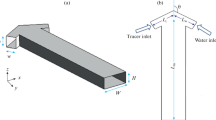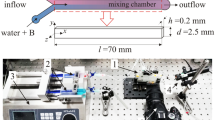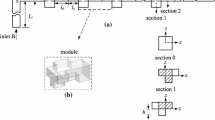Abstract
Both nonlinear rheology and finite EDL thickness effects on the mixing process in an electroosmotically actuated Y-sensor are being investigated in this paper, utilizing a depthwise averaging method based on the Taylor dispersion theory. The fluid rheological behavior is assumed to obey the power-law viscosity model. Analytical solutions are obtained assuming a large channel width to depth ratio for which a 1-D profile can efficiently describe the velocity distribution. Full numerical simulations are also performed to determine the applicability range of the analytical model, revealing that it is able to provide accurate results for channel aspect ratios of ten and higher and quite acceptable results for smaller aspect ratios down to four. The model is then used for a complete parametric study to determine the effects of the governing parameters on the mixing performance. It is observed that utilizing a fluid with a higher flow behavior index gives rise to a smaller mixing length. Moreover, whereas a larger EDL thickness is accompanied by an improved mixing efficiency, the opposite is true for the channel aspect ratio. The effective diffusivity is also found to be an increasing function of the EDL extent and a decreasing function of the flow behavior index.










Similar content being viewed by others
Abbreviations
- \(c\) :
-
Number concentration (m−3)
- \(c_{0}\) :
-
Inlet concentration (m−3)
- \(\bar{c}\) :
-
Depthwise averaged concentration (m−3)
- \(D\) :
-
Diffusivity (m−2 s−1)
- \(D_{\text{eff}}\) :
-
Effective diffusivity (m−2 s−1)
- \(e\) :
-
Proton charge (C)
- \(E_{x}\) :
-
Electric field in the axial direction (V m−1)
- \(H\) :
-
Half channel height (m)
- \(k_{B}\) :
-
Boltzmann constant (J K−1)
- \(L\) :
-
Channel length (m)
- \(m\) :
-
Flow consistency index (Pasn)
- \(n\) :
-
Flow behavior index
- \(n_{0}\) :
-
Ion density at neutral conditions (m−3)
- \(Pe\) :
-
Péclet number \({=}(\bar{u}H/D)\)
- \(t\) :
-
Time (s)
- \(T\) :
-
Absolute temperature (K)
- \(u\) :
-
Axial velocity (m s−1)
- \(\bar{u}\) :
-
Mean velocity (m s−1)
- \(W\) :
-
Half channel width (m)
- \(x,y,z\) :
-
Coordinates (m)
- \(\tilde{x}\) :
-
Axial coordinate of moving reference frame (m)
- \({\mathbb{Z}}\) :
-
Valence number of ions in solution
- \(\alpha\) :
-
Channel aspect ratio (=W/H)
- \(\delta\) :
-
Dimensionless thickness of diffusion layer
- \(\varepsilon\) :
-
Fluid permittivity (C V−1 m−1)
- \(\zeta\) :
-
Zeta potential (V)
- K :
-
Dimensionless Debye–Hückel parameter \([{=}H/\lambda _{D}]\)
- \(\lambda_{D}\) :
-
Debye length (m)
- \(\mu\) :
-
Effective viscosity (Pas)
- \(\mu_{0}\) :
-
Dynamic viscosity for a Newtonian behavior (Pas)
- \(\rho_{e}\) :
-
Net electric charge density (Cm−3)
- \(\psi\) :
-
EDL potential (V)
- \(\omega\) :
-
Scaling factor
- \(^{*}\) :
-
Dimensionless variable
References
Ahmadian Yazdi A, Sadeghi A, Saidi MH (2014) Rheology effects on cross-stream diffusion in a Y-shaped micromixer. Colloids Surf A 456(1):296–306
Aris R (1956) On the dispersion of a solute in a fluid flowing through a tube. Proc R Soc Lond Ser A 235:67–77
Beard DA (2001a) Response to “Comment on ‘Taylor dispersion of a solute in a microfluidic channel’ [J. Appl. Phys. 90, 6553 (2001)]”. J Appl Phys 90:6555–6556
Beard DA (2001b) Taylor dispersion of a solute in a microfluidic channel. J Appl Phys 89(8):4667–4669
Bird RB, Stewart WE, Lightfoot EN (2002) Transport phenomena, 2nd edn. Wiley, New York
Broboana D, Balan CM, Wohland T, Balan C (2011) Investigations of the unsteady diffusion process in microchannels. Chem Eng Sci 66:1962–1972
Chakraborty S (2007) Electroosmotically driven capillary transport of typical non-Newtonian biofluids in rectangular microchannels. Anal Chim Acta 605(2):175–184
Chakraborty D, Bose N, Sasmal S, Dasgupta S, Maiti TK, Chakraborty S, DasGupta S (2012) Effect of dispersion on the diffusion zone in two-phase laminar flows in microchannels. Anal Chim Acta 710:88–93
Chatwin PC, Sullivan PJ (1982) The effect of aspect ratio on in rectangular longitudinal diffusivity channels. J Fluid Mech 120:347–358
Chen JM, Horng T-L, Tan WY (2006) Analysis and measurements of mixing in pressure-driven microchannel flow. Microfluid Nanofluid 2:455–469
Chhabra RP, Richardson JF (2008) Non-Newtonian flow and applied rheology: engineering applications, 2nd edn. Butterworth-Heinemann, Oxford
Das S, Chakraborty S (2006) Analytical solutions for velocity, temperature and concentration distribution in electroosmotic microchannel flows of a non-Newtonian bio-fluid. Anal Chim Acta 559(1):15–24
Erickson D, Li D (2002) Influence of surface heterogeneity on electrokinetically driven microfluidic mixing. Langmuir 18(5):1883–1892
Gabriel C, Gabriel S, Corthout E (1996) The dielectric properties of biological tissues: I. Literature survey. Phys Med Biol 41:2231–2249
Gobby D, Angeli P, Gavriilidis A (2001) Mixing characteristics of T-type microfluidic mixers. J Micromech Microeng 11(2):126–132
Gorman BR, Wikswo JP (2008) Characterization of transport in microfluidic gradient generators. Microfluid Nanofluid 4:273–285
Hinsmann P, Frank J, Svasek P, Harasek M, Lendl B (2001) Design, simulation and application of a new micromixing device for time resolved infrared spectroscopy of chemical reactions in solution. Lab Chip 1(1):16–21
Holden MA, Kumar S, Castellana ET, Beskok A, Cremer PS (2003) Generating fixed concentration arrays in a microfluidic device. Sens Actuators B Chem 92:199–207
Ismagilov RF, Stroock AD, Kenis PJA, Whitesides G, Stone HA (2000) Experimental and theoretical scaling laws for transverse diffusive broadening in two-phase laminar flows in microchannels. Appl Phys Lett 76(17):2376–2378
Jeong S, Park J, Kim JM, Park S (2011) Microfluidic mixing using periodically induced secondary potential in electroosmotic flow. J Electrostat 69:429–434
Kamholz AE, Yager P (2001) Theoretical analysis of molecular diffusion in pressure-driven laminar flow in microfluidic channels. Biophys J 80:155–160
Kamholz AE, Yager P (2002) Molecular diffusive scaling laws in pressure-driven microfluidic channels: deviation from one-dimensional Einstein approximations. Sens Actuators B Chem 82:117–121
Kamholz AE, Weigl BH, Finlayson BA, Yager P (1999) Quantitative analysis of molecular interaction in a microfluidic channel: the T-sensor. Anal Chem 71:5340–5347
Karniadakis G, Beskok A, Aluru N (2005) Microflows and nanoflows, fundamentals and simulation. Springer, New York
Kirby BJ (2010) Micro- and nanoscale fluid mechanics; transport in microfluidic devices. Cambridge University Press, New York
Lam YC, Chen X, Yang C (2005) Depthwise averaging approach to cross-stream mixing in a pressure-driven microchannel flow. Microfluid Nanofluid 1(3):218–226
Lane DA, Patel IC, Sirs JA (1975) The variation of indicator dilution curves with velocity profile. Phys Med Biol 20:613–623
Malkin AY (1994) Rheology fundamentals. ChemTec, Toronto-Scarborough
Masliyah JH, Bhattacharjee S (2006) Electrokinetic and Colloid transport phenomena, 1st edn. Wiley, New Jersey
Mason LR, Ciceri D, Harvie DJE, Perera JM, Stevens GW (2013) Modelling of interfacial mass transfer in microfluidic solvent extraction: part I. Heterogenous transport. Microfluid Nanofluid 14:197–212
Paul S, Ng CO (2012) On the time development of dispersion in electroosmotic flow through a rectangular channel. Acta Mech Sin/Lixue Xuebao 28(3):631–643
Probstein RF (1994) Physicochemical hydrodynamics, 2nd edn. Wiley, New York
Sadeghi A, Fattahi M, Hassan Saidi M (2011a) An approximate analytical solution for electro-osmotic flow of power-law fluids in a planar microchannel. J Heat Transf 133(9):091701
Sadeghi A, Yavari H, Saidi MH, Chakraborty S (2011b) Mixed electroosmotically and pressure-driven flow with temperature- dependent properties. J Thermophys Heat Transf 25(3):432–442
Sadeghi A, Veisi H, Saidi MH, Chakraborty S (2012) Graetz problem extended to mixed electroosmotically and pressure-driven flow. J Thermophys Heat Transf 26(1):123–133
Salmon JB, Ajdari A (2007) Transverse transport of solutes between co-flowing pressure-driven streams for microfluidic studies of diffusion/reaction processes. J Appl Phys 101:074902
Sharma K, Bhat SV (1992) Non-Newtonian rheology of leukemic blood and plasma: Are n and k parameters of power law model diagnostic? Physiol Chem Phys Med NMR 24(4):307–312
Song H, Wang Y, Pant K (2012) Cross-stream diffusion under pressure-driven flow in microchannels with arbitrary aspect ratios: a phase diagram study using a three-dimensional analytical model. Microfluid Nanofluid 12(1–4):265–277
Song H, Wang Y, Pant K (2013) Scaling law for cross-stream diffusion in microchannels under combined electroosmotic and pressure driven flow. Microfluid Nanofluid 14(1–2):371–382
Sullivan SP, Akpa BS, Matthews SM, Fisher AC, Gladden LF, Johns ML (2007) Simulation of miscible diffusive mixing in microchannels. Sens Actuators B Chem 123:1142–1152
Taylor G (1953) Dispersion of soluble matter in solvent flowing slowly through a tube. Proc R Soc Lond Ser A 219(1137):186–203
Vakili MA, Sadeghi A, Saidi MH, Mozafari AA (2012) Electrokinetically driven fluidic transport of power-law fluids in rectangular microchannels. Colloids Surf A 414:440–456
Wang Y, Lin Q, Mukherjee T (2005) A model for laminar diffusion-based complex electrokinetic passive micromixers. Lab Chip 5:877–887
Wang Y, Mukherjee T, Lin Q (2006) Systematic modeling of microfluidic concentration gradient generators. J Micromech Microeng 16:2128–2137
Wang X, Wang S, Gendhar B, Cheng C, Byun CK, Li G, Zhao M, Liu S (2009) Electroosmotic pumps for microflow analysis. Trends Anal Chem 28(1):64–74
Yang C, Li D, Masliyah JH (1998) Modeling forced liquid convection in rectangular microchannels with electrokinetic effects. Int J Heat Mass Transf 41(24):4229–4249
Zhao C, Zholkovskij E, Masliyah J, Yang C (2008) Analysis of electroosmotic flow of power-law fluids in a slit microchannel. J Colloid Interface Sci 326(2):503–510
Zholkovskij EK, Masliyah JH, Yaroshchuk AE (2013) Broadening of neutral analyte band in electroosmotic flow through slit channel with different zeta potentials of the walls. Microfluid Nanofluid 15(1):35–47
Acknowledgments
The corresponding author sincerely thanks Iran’s National Elites Foundation (INEF) for their supports during the course of this work.
Author information
Authors and Affiliations
Corresponding author
Appendix
Appendix
The coefficients of the velocity distribution in Eq. (9) are given as
in which
Also, the coefficients of Eq. (20) are given as below
Finally, the coefficients of Eq. (21) are obtained as
in which \(a_{3} = K/\left( {K - \tanh{\textit{}} K} \right)\) and \(b_{3} = K/\left( {K\cosh{\textit{}} K - \sinh{\textit{}} K} \right)\).
Rights and permissions
About this article
Cite this article
Ahmadian Yazdi, A., Sadeghi, A. & Saidi, M.H. A depthwise averaging solution for cross-stream diffusion in a Y-micromixer by considering thick electrical double layers and nonlinear rheology. Microfluid Nanofluid 19, 1297–1308 (2015). https://doi.org/10.1007/s10404-015-1645-6
Received:
Accepted:
Published:
Issue Date:
DOI: https://doi.org/10.1007/s10404-015-1645-6




